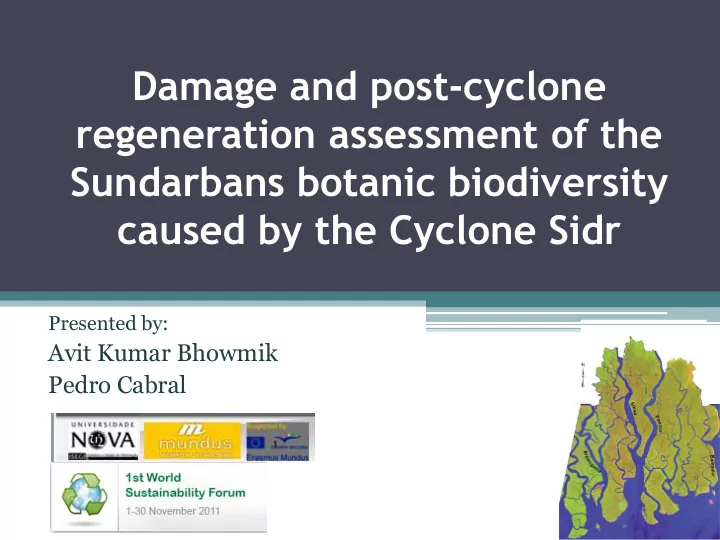

Damage and post-cyclone regeneration assessment of the Sundarbans botanic biodiversity caused by the Cyclone Sidr Presented by: Avit Kumar Bhowmik Pedro Cabral
Damage and post-cyclone regeneration assessment of the Sundarbans botanic biodiversity caused by the Cyclone Sidr The Sundarbans Forest Area Rivers
Damage and post-cyclone regeneration assessment of the Sundarbans botanic biodiversity caused by the Cyclone Sidr The Sundarbans • Largest single block of tidal halophytic mangrove forest in the world • Covers 10,000 sq.km. of which about 6,000 are in Bangladesh • Inscribed as a UNESCO world heritage site in 1997 • Renown for the eponymous Royal Bengal Tiger ( Panthera tigris tigris ) • The dominant mangrove species Heritiera fomes, locally known as Sundri or Sundari • Numerous flora and fauna
Damage and post-cyclone regeneration assessment of the Sundarbans botanic biodiversity caused by the Cyclone Sidr Cyclone SIDR November 15, 2007
Damage and post-cyclone regeneration assessment of the Sundarbans botanic biodiversity caused by the Cyclone Sidr Objectives (i) Identify changes in vegetation pattern in preceding and following periods of the tropical cyclone Sidr passage using unsupervised image classification and NDVI techniques. ii) Identify specific species damage and their regeneration until year 2010.
Damage and post-cyclone regeneration assessment of the Sundarbans botanic biodiversity caused by the Cyclone Sidr Sattelite Data • Landsat 7 ETM+ images of Sundarban area with spatial resolution of 30 metres and records in bands 1-6 of the periods ▫ 15 February 2007 ▫ 02 February 2008 ▫ 04 February 2009 ▫ 07 February 2010
Damage and post-cyclone regeneration assessment of the Sundarbans botanic biodiversity caused by the Cyclone Sidr Image Pre-processing • Combination of Mask Bands to minimise periodic line dropout error • Contrast Stretching - Histogram Equalization for Radiometric Enhancement
Damage and post-cyclone regeneration assessment of the Sundarbans botanic biodiversity caused by the Cyclone Sidr Image Pre-processing Raw Image of February 2007 Pre-processed Image of February 2007
Damage and post-cyclone regeneration assessment of the Sundarbans botanic biodiversity caused by the Cyclone Sidr Unsupervised Classification • Iterative Self-Organizing Data Analysis Technique (ISODATA)
Damage and post-cyclone regeneration assessment of the Sundarbans botanic biodiversity caused by the Cyclone Sidr Unsupervised Classification
Damage and post-cyclone regeneration assessment of the Sundarbans botanic biodiversity caused by the Cyclone Sidr Unsupervised Classification
Damage and post-cyclone regeneration assessment of the Sundarbans botanic biodiversity caused by the Cyclone Sidr Unsupervised Classification Analysis and Results from 2007 2008 2009 2010 Vegetation Types
Damage and post-cyclone regeneration assessment of the Sundarbans botanic biodiversity caused by the Cyclone Sidr Normalized Difference Vegetation Index (NDVI)
Damage and post-cyclone regeneration assessment of the Sundarbans botanic biodiversity caused by the Cyclone Sidr Normalized Difference Vegetation Index (NDVI)
Damage and post-cyclone regeneration assessment of the Sundarbans botanic biodiversity caused by the Cyclone Sidr Normalized Difference Vegetation Index (NDVI)
Damage and post-cyclone regeneration assessment of the Sundarbans botanic biodiversity caused by the Cyclone Sidr Analysis and Results from NDVI 2007 2008 2009 2010 NDVI values
Damage and post-cyclone regeneration assessment of the Sundarbans botanic biodiversity caused by the Cyclone Sidr Analysis and Results from NDVI Area covered by From February From February From February 2009 NDVI Values 2007 to February 2008 to February to February 2010 2008 2009 0-0.08 Increased by 95% Decreased by 7% Decreased by 77% 0.08-0.16 Increased by 14% Increased by 8% Decreased by 51% 0.16-0.24 Decreased by 21% Increased by 70% Decreased by 39% 0.24-0.29 Increased by 77% Decreased by 80% Increased more than 90% 0.29-0.34 Increased by 30% Decreased by 91% Increased more than 95% 0.34-0.42 Increased by 25% Decreased by 25% Increased more than 98% 0.42-0.54 No Change No Change Increased by 100% 0.54-0.97 No Change No Change Increased by 100% 0.97-1 No Change No Change No Change
Damage and post-cyclone regeneration assessment of the Sundarbans botanic biodiversity caused by the Cyclone Sidr Accuracy Assessment (Classified Image) Reference Map of Species Distribution from Classified Image of February 2007 Forest Department of Bangladesh, 2002
Damage and post-cyclone regeneration assessment of the Sundarbans botanic biodiversity caused by the Cyclone Sidr Accuracy Assessment (Classified Image) Species type Species type Water Row total 1 2 Species type 9 9 0 18 1 Species type 3 19 0 22 2 Water 0 0 10 10 Column total 12 28 10 50 Overall accuracy = 76 % Producer’s accuracy User’s accuracy (%) Class (%) Species type 1 50 75 Species type 2 86.36 67.86 Water 100 100
Damage and post-cyclone regeneration assessment of the Sundarbans botanic biodiversity caused by the Cyclone Sidr Accuracy Assessment (NDVI Map) NDVI Map of February 2010 Reference Map from Google Earth of November 2010
Damage and post-cyclone regeneration assessment of the Sundarbans botanic biodiversity caused by the Cyclone Sidr Accuracy Assessment (NDVI Map) Fallow Sundarban Other Waterbody Total land Vegetation Vegetation Fallow Land 2 0 1 0 3 Sundarban 0 30 0 0 30 Vegetation Other 0 2 4 0 6 Vegetation Waterbody 0 3 0 8 11 Total 2 35 5 8 50 Overall Accuracy = 88% Classes Producer Accuracy User Accuracy Fallow Land 66.67% 100% Sundarban 100% 85.71% Vegetation Other 66.67% 80% Vegetation Waterbody 72.73% 100%
Damage and post-cyclone regeneration assessment of the Sundarbans botanic biodiversity caused by the Cyclone Sidr Major Findings • Around 45% area (2500 sq.km.) of the study region has been damaged by cyclone SIDR • The eastern part of the region was affected largely because of closeness to cyclone trajectory • Sundari ( Heritiera fomes ), Gewa ( Excoecaria agallocha ) and Kewra ( Sonneratia mangrove) were the species which have been largely affected by cyclone SIDR • The regeneration rate in 2009-2010 is 4 times higher than the regeneration rate in 2008-2009
Thank you All
Recommend
More recommend